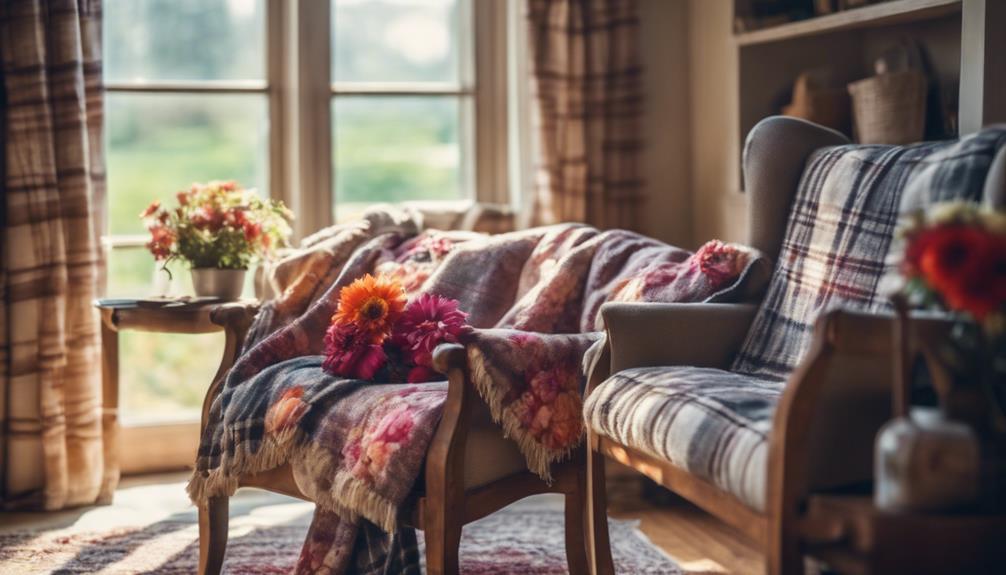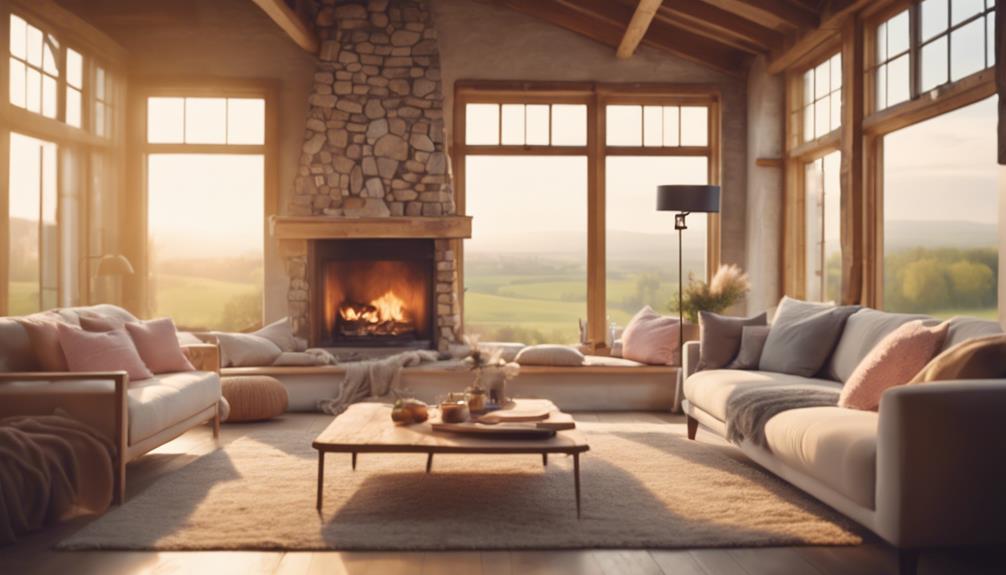When choosing between floral and plaid for your country living room, consider the vibe you want to create. Floral patterns bring a light, airy feel, perfect for a cheerful space, while plaid adds warmth and rustic charm. Pairing soft pastels with muted plaids can provide balance and visual interest. Think about your fabric choices too; cotton works well for florals, while wool suits plaid, especially in colder months. Layering textures enhances depth, making your room cozy. Want to know more about integrating these patterns effectively? There are plenty of stylish options to explore that can perfectly complete your look.
Key Elements
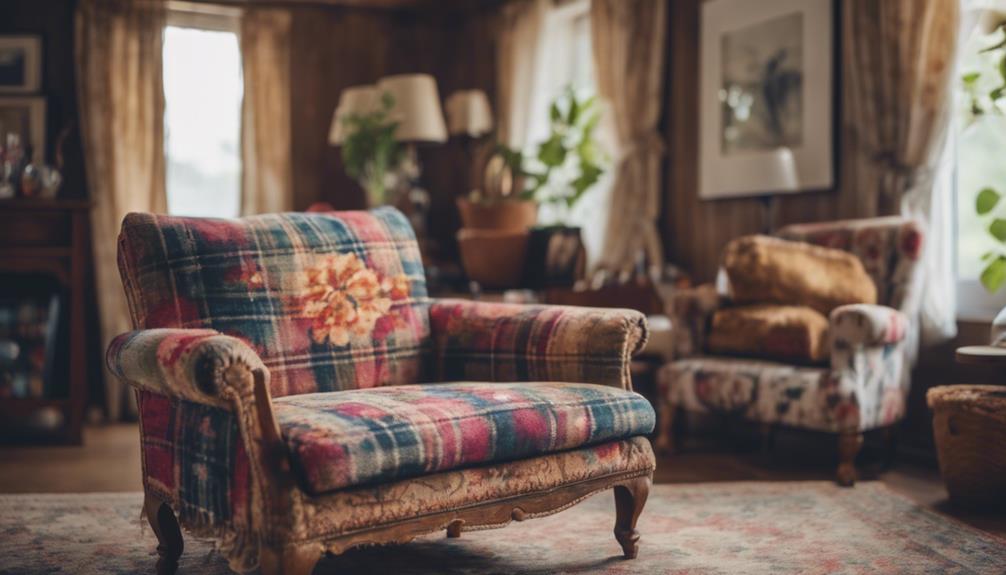
When picking the right pattern for your living room, you can't overlook key elements like color scheme, materials, and textures.
These factors play an essential role in how the overall design feels and functions.
Color Scheme
Choosing the right color scheme can transform your country living room, setting the mood and enhancing the charm of floral and plaid patterns.
Think about the overall vibe you want; floral designs bring a light, airy feel, while plaid patterns add warmth and coziness. To achieve visual harmony, consider incorporating complementary colors. Pair soft pastel florals with muted plaid tones for an inviting atmosphere.
A neutral backdrop, like beige or soft gray, allows both floral and plaid patterns to shine without clashing. Pay attention to the scale of your patterns; balance large floral prints with smaller plaid accents to maintain cohesion in your color scheme.
Don't overlook seasonal color trends. Earthy tones like terracotta and olive green are popular in country decor, enriching the rustic feel.
When combined with floral and plaid elements, these colors can enhance your living room's overall aesthetic. By thoughtfully selecting your color scheme, you'll create a space that feels both stylish and welcoming, making it the perfect gathering spot for family and friends.
Materials
Selecting the right materials is essential for achieving a cozy and inviting atmosphere in your country living room. When you're choosing materials, consider using cotton or linen for your floral patterns. These fabrics provide a soft and breathable texture that enhances your room's warmth. For plaid, opt for wool or flannel, especially in colder months. They not only offer durability but also add a classic charm that complements the country aesthetic.
Mixing materials can elevate your decor. Pairing cotton floral upholstery with wool plaid throws creates a balanced layer of comfort and visual interest. To maintain a cohesive look, make sure your chosen materials reflect your color palette, allowing the floral and plaid patterns to harmonize beautifully.
Don't forget about grounding your design; incorporating natural fibers like jute or sisal rugs can tie everything together. These elements add a rustic touch that seamlessly blends with both floral and plaid accents, enhancing the overall appeal of your living room.
Textures
Textures greatly enhance the visual and tactile appeal of your country living room, adding warmth and depth to your design. By using a variety of materials like soft fabrics, natural fibers, and rustic finishes, you create a cozy atmosphere that invites relaxation.
When you combine plaid and floral patterns, you achieve a striking textural contrast. The structured feel of plaid beautifully balances with the soft, organic touch of floral designs. Layering different textures is key to adding depth. For instance, draping a plaid throw blanket over a floral couch can create a warm, inviting look.
Don't forget the natural textures, like wood and stone, which can ground the overall aesthetic and enhance the cozy vibe of your space. These elements work harmoniously with both plaid and floral patterns.
Using various textile weights is also essential. Heavier plaid upholstery can provide structure, while lightweight floral curtains allow light to filter in, creating a balanced and inviting atmosphere.
Essential Fixtures and Furniture

When it comes to essential fixtures and furniture for your living room, choosing pieces with plaid patterns can really elevate the space.
A plaid-upholstered accent chair or a coffee table adorned with a plaid design can create a cohesive look while adding character.
Don't forget a plaid-trimmed ottoman to complete the inviting atmosphere you're aiming for.
Plaid-Upholstered Accent Chair
A plaid-upholstered accent chair can instantly elevate your living room, serving as a striking focal point that adds both style and comfort. The versatility of the plaid pattern allows it to complement various color schemes and decor styles, from rustic charm to contemporary elegance. Choosing a two-toned or neutral plaid can anchor your design without overwhelming the space, making it perfect for larger applications.
When you opt for a plaid accent chair, consider how it pairs with your existing furniture. Solid-colored sofas or other patterns can create a dynamic yet cohesive look, enhancing the overall aesthetic of your room. Pay attention to the scale of the plaid pattern as well; it should harmonize with other design elements to achieve a balanced appearance.
Incorporating a plaid accent chair not only adds texture but also invites guests to sit and enjoy the comfort it provides. So, whether you're entertaining friends or curling up with a good book, this piece will surely become a favorite spot in your country living room.
Choose wisely, and your plaid accent chair will enhance both the style and functionality of your space.
Plaid-Patterned Coffee Table
Often overlooked, a plaid-patterned coffee table can become a striking centerpiece in your living room, blending functionality with a touch of rustic charm. Its large pattern draws the eye, enhancing the country aesthetic while providing ample surface space for drinks and decor. When choosing a plaid coffee table, think about the scale and color of the pattern to guarantee it complements your existing decor without feeling overwhelming.
Plaid coffee tables come in various materials, from sturdy wood to soft fabric overlays, adding texture and warmth to your space. To create a cohesive look, consider pairing the table with plaid pillows on your sofa, which can tie the whole room together and emphasize the rustic vibe. A two-toned plaid design can effectively balance boldness and subtlety, allowing you to adapt your decor for seasonal changes.
Don't forget to style your coffee table with complementary items like coasters and books, which can enhance its visual interest and make it a conversation starter. By incorporating a plaid-patterned coffee table, you'll elevate your country living room's charm and create a welcoming atmosphere.
Plaid-Trimmed Ottoman
Integrating a plaid-trimmed ottoman into your living room not only enhances comfort but also adds a stylish touch to your decor. This versatile piece serves as a functional footrest while doubling as a decorative accent. The warm plaid upholstery introduces visual interest, perfectly complementing rustic elements in your country-inspired space.
When selecting colors and patterns, consider using neutral or earthy tones in your plaid ottoman. These shades enhance the cozy ambiance associated with country decor and maintain a timeless appeal. A plaid-trimmed ottoman can easily coordinate with various furniture styles, whether traditional or modern, without overwhelming your space.
Moreover, adding this ottoman allows you to mix and match patterns within your living room. Pair it with a floral print or a solid color to create a balanced look that feels inviting and stylish. You might even consider throwing a cozy plaid throw over the ottoman to tie everything together and add an extra layer of warmth.
Lighting Ideas
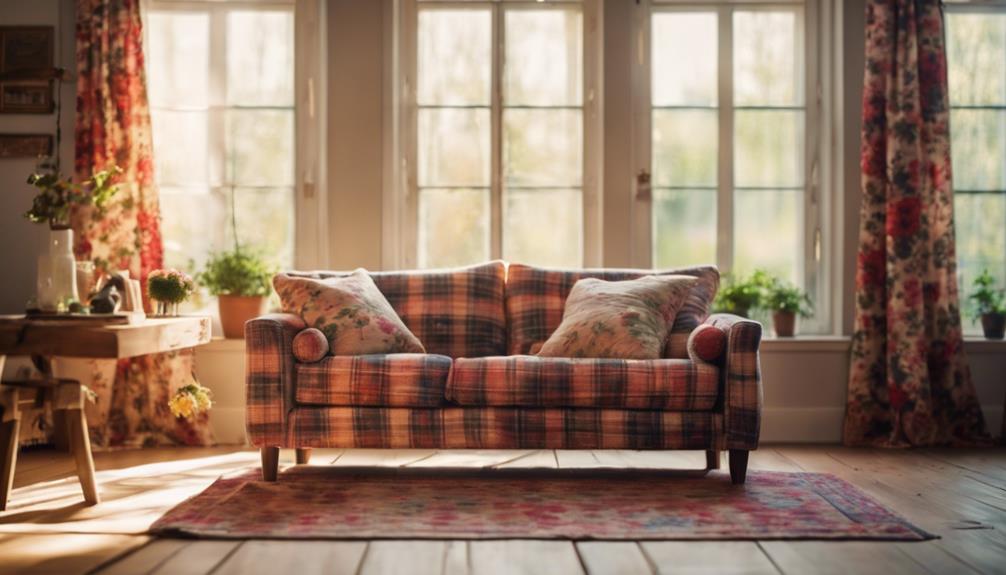
When it comes to lighting, you'll want to choose fixtures that enhance your living room's country charm.
Vintage farmhouse pendant lights and rustic lantern-style wall sconces can add character, while a farmhouse-style chandelier fixture serves as a stunning focal point.
Don't forget an antique brass table lamp to complete the cozy atmosphere and tie your design together.
Vintage Farmhouse Pendant Lights
Enhancing your living room with vintage farmhouse pendant lights adds a rustic charm that perfectly complements country decor. These lights typically feature materials like distressed wood, metal, or glass, creating an inviting atmosphere in your home. Incorporating elements such as Edison bulbs not only provides a warm glow but also adds a nostalgic touch to your lighting, making your space feel cozy and welcoming.
One of the great advantages of vintage farmhouse pendant lights is their versatility. Many designs are adjustable in height, allowing you to position them perfectly over dining tables, kitchen islands, or living areas. This flexibility guarantees that they fit seamlessly into your home decor.
Their neutral colors and simple, classic shapes make vintage farmhouse pendant lights easy to integrate with various styles, including floral and plaid patterns. As you choose decor elements, consider how these lights can enhance the overall ambiance of your living room.
Rustic Lantern-Style Wall Sconces
If you love the rustic charm of vintage farmhouse pendant lights, rustic lantern-style wall sconces are a perfect addition to elevate the ambiance of your living room. These sconces come in various materials like wrought iron, wood, and glass, often featuring warm colors and finishes that enhance your country decor. Their vintage or antique designs evoke a cozy, nostalgic feel, seamlessly complementing your rustic aesthetics.
When you're choosing sconces, consider how they'll fit into your space. Look for options that accommodate energy-efficient LED bulbs, allowing you to enjoy both the ambiance and practicality while keeping energy consumption low. The straightforward installation means you can opt for hardwired or plug-in styles, giving you flexibility in placement.
Remember to think about the height and positioning of your sconces. Proper placement guarantees they provide adequate lighting while maintaining the desired aesthetic in your country living room.
Farmhouse-Style Chandelier Fixture
Choosing a farmhouse-style chandelier fixture can instantly transform your living room, adding a touch of rustic elegance that complements your decor. These fixtures often feature materials like wood, metal, or wrought iron, perfectly aligning with the cozy vibe of country living rooms. Look for options that incorporate exposed bulbs or vintage-style lanterns, enhancing the warmth and charm of your space.
When selecting your chandelier, consider size and scale. Larger fixtures can serve as a stunning focal point in spacious areas, while smaller designs are ideal for cozy nooks. Adjustable height features are also popular, allowing you to customize the chandelier based on your ceiling height and room design.
A mix of traditional and modern designs in farmhouse chandeliers creates a unique aesthetic that pairs beautifully with both floral and plaid patterns. This versatility means you can easily switch up your decor while keeping your lighting in harmony.
Antique Brass Table Lamp
A well-placed antique brass table lamp can beautifully complement your farmhouse-style chandelier, adding a vintage charm that enriches your living room's rustic decor. The warm glow from these lamps creates a cozy atmosphere, perfect for relaxation or social gatherings. Their durability guarantees they not only look elegant but also stand the test of time, making them a wise investment for your decor.
When selecting an antique brass table lamp, consider intricate designs or finishes that can serve as decorative focal points in your room. Pairing these lamps with plaid patterns can elevate the overall aesthetic, creating a harmonious balance between classic elegance and charming country style. The texture and colors of plaid patterns can enhance the warm tones of the brass, providing a welcoming and inviting space.
Whether you choose a lamp with a traditional silhouette or a more contemporary design, the antique brass table lamp will seamlessly fit into your country living room. It's all about finding the right balance between patterns and textures, making sure that your lighting choice enhances the rustic charm you're aiming for. With the right lamp, your living room will radiate warmth and style.
Decorative Elements

When it comes to decorative elements, plaid can really elevate your living room's style.
Consider incorporating plaid-patterned wall art, a cozy plaid-embroidered throw blanket, or a functional plaid-patterned decorative wall clock to bring a unified look to your space.
These accents not only add personality but also create a warm, inviting atmosphere that ties everything together.
Plaid-Patterned Wall Art
Plaid-patterned wall art transforms your living room into a cozy retreat, adding both warmth and graphic interest that enhances its rustic charm.
You'll find that using plaid wall art can serve as a bold focal point, drawing the eye and creating a welcoming atmosphere. Consider incorporating blue and white plaid designs to introduce a fresh, crisp look that complements natural materials like wood and stone.
Using framed plaid fabric or canvas prints adds a tactile dimension to your walls, providing depth while maintaining a cozy ambiance. You can mix and match various sizes and color schemes of plaid-patterned wall art, allowing you to easily blend with other decor elements for a cohesive style.
Additionally, seasonal plaid designs can be swapped out, giving you an effortless way to refresh your country living space throughout the year.
Whether you choose large statement pieces or a gallery wall of smaller prints, these elements will enhance your home's earthy aesthetic and make your living room feel uniquely yours. Embrace the charm of plaid-patterned wall art, and watch your space transform into a delightful haven.
Plaid-Embroidered Throw Blanket
Adding a plaid-embroidered throw blanket to your living room not only enhances the cozy vibe established by plaid wall art but also brings an inviting layer of texture and warmth to your space. This versatile decorative element serves a dual purpose, offering both functional warmth and visual appeal in your country living room.
The textured nature of the plaid-embroidered patterns adds depth and interest, making it a perfect match for rustic or farmhouse-style decor. When choosing your plaid-embroidered throw blanket, consider the color schemes that harmonize with your existing furnishings. Doing so creates a cohesive look that ties your living space together beautifully.
With a wide range of plaid patterns available, from classic tartans to modern interpretations, you can select a blanket that reflects your unique style. Additionally, this throw blanket provides seasonal versatility, making it ideal for cozy winter nights or as a stylish accent during warmer months.
Plaid-Patterned Decorative Wall Clock
A decorative wall clock featuring a plaid pattern instantly becomes a striking focal point in your country living room, blending functionality with stylish design. Opting for a large-scale plaid-patterned clock can create a dramatic effect, drawing the eye without overwhelming the space. The versatility of plaid allows it to complement various color schemes, enhancing the rustic charm of your decor while adding visual interest.
These clocks come in a variety of materials, such as wood and metal, providing options to suit your personal aesthetic. A plaid-patterned wall clock not only keeps you on schedule but also harmonizes beautifully with other elements in your room, whether they're plaid or floral. This promotes a cohesive and inviting atmosphere, making your living room feel more complete.
When choosing a plaid-patterned wall clock, consider how its colors and scale will work with existing decor. A large-scale design can serve as an eye-catching statement piece that ties together your room's overall theme.
Ultimately, a plaid wall clock is a practical choice that enhances the country living room vibe while showcasing your style.
Flooring
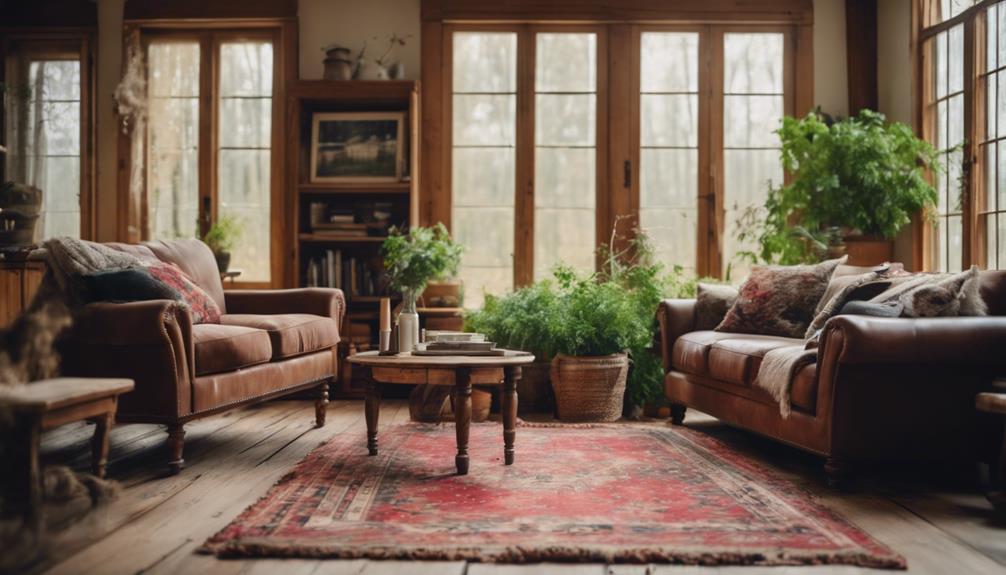
When you're selecting flooring for your living room, consider options that enhance your chosen patterns.
Reclaimed barn wood, cottage-style painted wood, and cottage-inspired laminate flooring can all complement floral and plaid designs beautifully.
Each option not only adds character but also helps create a warm, inviting atmosphere.
Reclaimed Barn Wood Flooring
Reclaimed barn wood flooring brings a unique character and rich history to your living room, making it a standout choice for country-style interiors.
Sourced from old barns and agricultural buildings, this flooring option features natural imperfections like knots, nail holes, and varying grain patterns, enhancing the rustic charm of your country cottage.
One of the key benefits of reclaimed barn wood is its sustainability. By repurposing materials that would otherwise end up in landfills, you're not only adding beauty to your space but also reducing your environmental impact.
Additionally, the durability of reclaimed wood is impressive; many planks are over a century old and can withstand wear and tear when properly maintained.
When it comes to installation, you have the flexibility to choose various patterns, such as herringbone or straight lay, allowing you to personalize your design aesthetic.
This adaptability makes reclaimed barn wood flooring a versatile choice that complements a range of decor styles in your living room.
Cottage-Style Painted Wood Flooring
Cottage-style painted wood flooring offers a charming and customizable foundation for your living room, enhancing its rustic appeal with soft, inviting colors. This flooring typically features muted shades that create a warm atmosphere, perfect for complementing your floral or plaid decor. You can choose a lovely blue hue or another soft color to match your overall aesthetic.
One of the best aspects of painted wood flooring is the ability to incorporate various patterns and designs that reflect your personal style. Whether you prefer a classic checkered look or a more whimsical motif, the options are nearly endless. Additionally, this flooring is easy to maintain; a simple coat of paint can refresh its appearance whenever you want a change.
The texture of painted wood adds character and depth to your living space, enhancing the cozy feel of cottage-style interiors. Plus, it works well with underfloor heating, ensuring comfort during those colder months without compromising on style.
With cottage-style painted wood flooring, you'll achieve a beautiful balance of functionality and aesthetic charm in your country living room.
Cottage-Inspired Laminate Flooring
If you love the rustic charm of painted wood flooring but want a more durable and budget-friendly option, cottage-inspired laminate flooring can be the perfect choice for your living room. This flooring mimics the look of traditional hardwood, featuring soft, muted colors and distressed finishes that evoke warmth and coziness.
Not only does cottage-inspired laminate flooring offer an inviting aesthetic, but it also provides practicality. It's a cost-effective alternative that requires less maintenance than hardwood, allowing you to enjoy its beauty without constant upkeep.
Plus, modern laminate options have excellent water resistance, making them suitable for high-traffic areas or homes with kids and pets.
Installing laminate flooring is straightforward, often allowing you to take on the project as a DIY task, making it accessible for any homeowner looking to refresh their space.
When mixing patterns in your living room, consider how the laminate's design complements floral or plaid textiles. The right combination can create a harmonious atmosphere that captures the essence of country living while showcasing your personal style.
Embrace the charm and functionality of cottage-inspired laminate flooring for a stunning, practical living room!
Conclusion
When it comes to choosing between floral and plaid for your country living room, consider your personal style and the atmosphere you want to create. If you want a more traditional and cozy feel, then plaid might be the better choice. However, if you prefer a more vibrant and feminine look, then floral patterns could be the way to go. You can also mix and match both patterns for a more eclectic look, like using plaid for the sofa and floral for the best pillow cases. This way, you can create a unique and personalized space that reflects your individual style preferences.
Floral patterns can add a touch of romance and softness, while plaid offers a cozy, rustic vibe.
Ultimately, it's all about what makes you feel at home.
Don't be afraid to mix and match patterns with your essential fixtures and decorative elements to achieve a unique look that reflects your personality.
